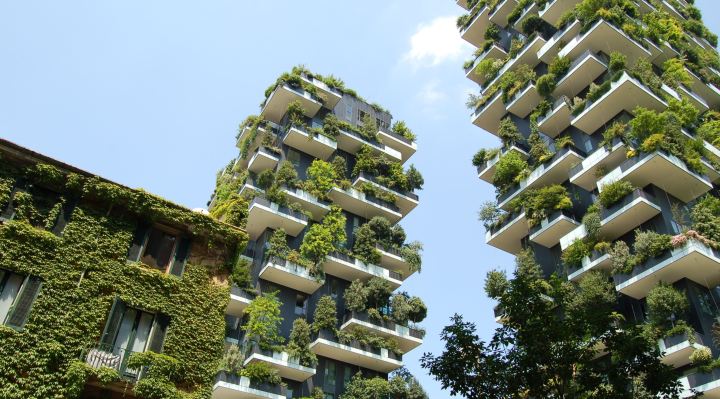
02 May Why Green Building May Be a Key to Affordable Housing
Green building and affordable housing continue to find new ways to fit together as the construction industry transforms. People who live in low-income housing often benefit the most from energy-efficient structures, which has prompted companies to develop ideas for combining both while keeping rent affordable. So, how is green building making an impact, and what specific techniques are contributing to an environmental and social solution to a housing affordability crunch?
The Impact of Sustainable Building on the Housing Affordability Crisis
Sustainable buildings tend to pay themselves off quickly, providing an immediate ROI for wary landlords and real estate agents. Green buildings offer numerous advantages for landlords and tenants in the affordable housing sector — including safer structures and healthier lives. Upgrading existing buildings to fit current green building codes often costs less than forming new structures. Some contractors and landlords worry about the upfront expenses for newly built housing, but retrofitting old buildings put many of these fears to rest.
This method provides an ideal alternative for renters who can’t afford to move into a brand new place. Utility companies also benefit from investing in these retrofitted homes — they gain monetary savings that would otherwise go to building new stations. The Green Communities Criteria from Enterprise ensures resource preservation, healthy homes, and energy-efficient practices within low-income communities. One of their latest goals includes maintaining carbon-neutral properties, which will output net-zero carbon emissions. They’ve been a pioneer in merging affordable housing with sustainability, and their efforts are reinforced by the growing desire for eco-friendly living spaces. Implementing green construction depends on the structure of each city, community, and individual building. Though the methods and strategies are different, the benefits are the same. Eco-friendly homes see improvements in energy usage, water conservation, and more.
1. Waste Reduction
Sustainable building techniques incorporate better handling of solid waste so less of it occupies landfills. It goes toward ensuing projects instead, where it can undergo recycling for as many times as its lifespan allows. Construction and demolition waste poses health risks as well as conservation issues, especially in low-income areas. Open dumping and mismanagement can result in heavy metal pollution and marine litter, which have adverse effects on humans and animals. The waste reduction doesn’t end with construction, however. Many green homes incorporate greywater usage and low-flow toilets, showers, and sinks. Reusing and conserving water keeps water bills low and gives back to the environment — a win-win for all.
2. Energy Savings
Energy savings have been a huge selling point for landlords in switching to the green initiative. Efficient HVAC systems, increased natural lighting, and insulated windows mean lower energy bills for everyone. U.S. landowners can save $126 billion in energy costs through 2040 by following green building codes. LEED-certified buildings have also averted 33 metric tons of carbon dioxide from 2000 to 2016 in six countries, including the US, India, and China. Housing projects that implement solar power or roof gardens can also make major energy gains while keeping inside temperatures stable. Features like these are both beneficial and eye-catching and entice renters to make their homes within the area.
3. Efficient Construction
Currently, commercial and residential buildings consume about one-third of the world’s energy. Yet the IEA reports these buildings could actually account for 41% of global energy savings by 2035 — if construction practices become more energy-efficient. Fortunately, a new type of housing has sprung into the market — modular building. Workers create these buildings in off-site factories. They arrive at construction sites in separate modules, which can then be merged in less time than it takes to erect conventional housing. Construction sites can be unpredictable, and natural elements like rain or snow disturb or halt operations. Modular construction defeats these interruptions by keeping the process contained and streamlined for efficiency. Builders theorize this innovation can take up to 50% less time than standard on-site projects. All waste created from modular construction is recyclable, and workers can disassemble these buildings for use in other projects. This method cuts down on the amount of energy needed to harvest and build new materials.
4. Better Locations
Green buildings are environmentally sound in virtually every aspect you can think of, and this includes transportation. Contractors who build eco-friendly houses and apartments locate them in areas close to public transportation. Many structures exist in city centers where subways, buses, and rideshares are populous. Residents are more likely to catch rides or walk to work, which reduces car usage. While public transportation has a fair share in contributing to climate change, the U.S. Green Building Council is combating this through transit certifications. Transit owners will have a set of guidelines to follow in upholding sustainability and educating riders on conservation.
5. Cost-Efficient Materials
Sustainable construction gains part of its reputation from its building materials. Adhering to green standards — whether those be LEED or Green Globes — requires builders seek to better alternatives to toxic, costly materials. The subsequent materials are often easier to handle, healthier for living beings, and cost-effective. Recycled metal and reclaimed wood are two such materials. Both of these require less energy to reuse than to create. Workers often salvage them from demolished buildings, which eliminates the need to pay high prices for brand new supplies. Renewable resources like bamboo, wool, and cork can be replenished abundantly, reducing the chance of shortages.
Sustainable Housing Equals Affordable Housing
Creating better communities means paying attention to the needs of those who occupy those spaces. Builders are continually working to develop green initiatives that provide both individual and community-wide benefits. More families will find homes in eco-approved housing through sustainable innovations in the construction industry.


